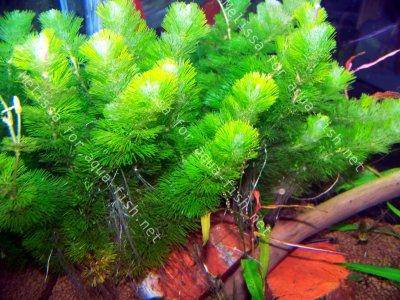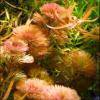Cabomba caroliniana
Scientific name: Cabomba caroliniana
Family: Cabombaceae
Maximum size reached under cultivation: 50 - 100 cm (19.69 - 39.37 inch)
014
Recommended pH range: 6 - 7.5
Recommended water hardness: 2 - 10°dGH (35.71 - 178.57ppm)
0°C 32°F30°C 86°F
Recommended temperature range: 22 - 28 °C (71.6 - 82.4°F)
Preferred propagation method: Cuttings
Native to: Central America
Growth rate: Fast
Recommended substrate: Rocky
Lighting requirements: Bright
Ideal placement in tank: Background
🌿 Common Names
Fanwort, Green Cabomba, Carolina Fanwort, Fish Grass
🌍 Origin
Cabomba caroliniana is native to southeastern North America (including Florida and Louisiana) and parts of South America, such as Brazil and Argentina. Over time, it has spread globally and is now considered invasive in several regions. It thrives in slow-moving, nutrient-rich freshwater environments like marshes, ponds, and quiet streams.
💡 Lighting Requirements
Cabomba caroliniana requires bright to very bright lighting to maintain its dense, lush appearance. Insufficient light leads to thinning, decay of lower leaves, and elongated, weak stems. A full-spectrum light that mimics natural daylight is ideal. Provide 8–10 hours of bright light daily for best results. Supplementing with iron-based fertilizers enhances color vibrancy.
💧 Water Parameters
- Temperature: 22–28 °C (71.6–82.4 °F)
- pH: 6.0–7.5
- Water Hardness: Soft to moderately hard (up to 10 °dGH)
🌱 Propagation
Cabomba caroliniana propagates easily via stem cuttings. Trim healthy stems just below a node, remove lower leaves, and gently insert the cutting into the substrate. Grouping several cuttings together produces a fuller, bushier effect. With optimal conditions, new roots develop quickly.
⚖️ Difficulty
Moderate. While not highly demanding, it requires consistent lighting, nutrient availability, and stable water conditions. Beginners may find it challenging without sufficient light or in unstable tanks.
🏦 Planting Area
This plant is best suited for the background of aquariums, where it forms dense thickets that provide shelter for small fish and fry. It can also be used along the sides of the tank to frame aquascapes naturally.
🌳 Additional Notes
- CO₂ injection is not required but significantly improves growth density and health.
- Regular pruning is essential to prevent excessive shading and promote bushier growth.
- Due to its invasive nature, never dispose of Cabomba into natural water bodies.
📝 Short Description
Cabomba caroliniana is a delicate yet popular aquatic plant that adds elegance and softness to aquascapes. Its feathery, fan-like leaves sway gently with water movement, creating a calming effect. Despite its fragile stems, it rewards careful aquarists with lush greenery and excellent shelter for aquatic life. In aquariums, Cabomba is often used to hide equipment like heaters or filters, helping to create a more natural and visually appealing environment. However, it’s important to note that it is a favorite snack for many herbivorous fish, so placement and tank mates should be chosen carefully. Proper lighting, trimming, and stable conditions are key to maintaining its beauty long-term.


 Cabomba furcata
Cabomba furcata